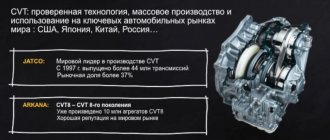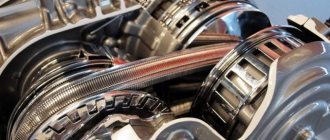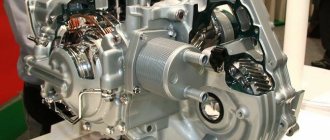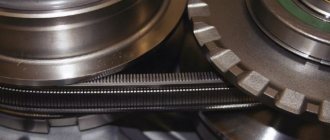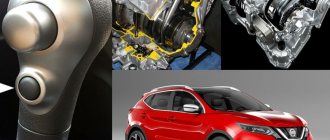CVTs Jatco JF010E and JF011E have a large number of advantages compared to other types of automatic transmissions. They have good traction, provide fuel economy and low emissions of harmful substances into the atmosphere. But since these models are the most widely installed, we will tell you about their reliability and service life.
JF010E and JF011E can be classified as Jatco's second generation CVTs. The JF010E model is installed with 3.5 liter naturally aspirated petrol engines, and the JF011E variator is installed with 2.5 and 2.0 liter engines. They are identical in design, only a few elements were made more reinforced to maintain engine torque.
Different car manufacturers designate Jatco JF010E and JF011E CVTs differently. Jatco JF010E = RE0F09A/B (Nissan) Jatco JF011E = RE0F10A/B/C (Nissan, Suzuki) = W1CJA / F1CJA (Mitsubishi, Peugeot), FK0/FK8 (Renault), CVT2/CVT2M (Jeep, Dodge). See the full list of automakers that have installed Jatco CVTs here.
The average declared resource of these Jatco JF010E and JF011E CVTs is 150,000-200,000 km. However, with active driving and daily city use, the service life can be reduced to 100,000 km. By the end of operation, many parts wear out: cones, cone bearings, belts, valves in the valve body and oil pump, step motor, pressure reducing valve.
Jatco JF010E /JF011E are rebuildable and can be repaired. The cost of a complete restoration is high. An official dealer can only sell you a valve body assembly or a new variator. But you can buy original spare parts separately on the market. You can also buy a contract variator through suppliers and the price will be about $900-1500, depending on the mileage.
Jatco JF010E Jatco JF011E
SMOOTH RIDE
The second most common malfunction is jerking and jerking of the car. The main culprit is the oil pump pressure reducing valve. Due to wear products getting on the friction surfaces, it jams in intermediate positions. As a result, the pressure in the system does not correspond to the norm, which leads to a mismatch in the operation of the drive and driven pulleys and belt slippage. If you contact the service in time, the repair will be cheaper: in case of minor damage, the conical surfaces of the pulleys can be treated by grinding. But the belt will have to be changed. The approximate cost of repairs, including costs for spare parts, is 60,000–80,000 rubles.
Useful information | Typical faults | Repair
Over the past few years, the CVT has moved from the category of exotic to the category of a completely familiar “automatic” and has managed to survive several serious crises, either gaining the status of a reliable continuously variable transmission or losing precious reputation points.
If German automakers have taken the predominantly robotic route of shaft gearboxes, then Japanese engineers, like several years ago, still focus on improving and producing continuously variable transmissions. Jatco, one of the largest manufacturers of automobile transmissions, has been particularly successful in this direction. The company is owned by Nissan (75% shares), Mitsubishi (15% shares) and Suzuki (10% shares). Boxes produced by Jatco are most often found on cars of the Nissan-Renault group. The JF011E variator, which used to be equipped with most Japanese passenger cars, is considered a real bestseller. But already in 2012, the JF011E is being replaced by a new modification of the CVT - JF016E, which will be destined to replace its predecessor virtually everywhere within a few years, where it was installed. Also in 2012, the JF017E gearbox appeared and it became the main one for Nissan and Renault cars with engines from 250 to 400 Nm of torque. Next we’ll talk about the reliability of these two continuously variable transmissions.
CVT JF016E
The JF016E continuously variable transmission is designed for medium and premium class cars with an engine up to 2.5 liters. It replaced the tenth family, becoming part of the CVT8 series, so the JF016E CVT is also labeled as Xtronic CVT8 RE0F10D. Despite the fact that a whole generation change has occurred, new units are designed on the basis of their ancestors. In fact, the new CVT inherited the entire engine range from the well-known JF011E, the circulation of which by 2012 was breaking all absolute records and was approaching the mark of 5 million units produced. The Japanese have taken a very sensitive approach to the issue of mass production of cars with an updated continuously variable transmission. At first, the JF016E was installed exclusively on the Nissan Serena and Altima with a 2.0 and 2.5 liter engine, respectively, as well as on a smaller power unit in the Renault Clio. The first tests made it clear that there were some electronic diseases. The initial CVT settings turned out to be aggressive, which led to early failure of the valve body. It was replaced under warranty, and after that the Japanese modified the firmware of the electronic unit, which was the solution to the problem.
Buy spare parts for variator JF016E/JF017E
After minor adjustments, the continuously variable transmission was installed on the group’s mass-produced cars – Nissan Teana 2.0/2.5 and Qashqai 2.0. At first, these cars were tested exclusively in Japanese operating conditions, and only in 2014 a new modification of the variator began to conquer the hearts of car enthusiasts around the world. The box began to be installed on the Chevrolet City Express, Mitsubishi Outlander, Lancer and ASX. This is not the entire list of models equipped with JF016E. Since 2013, CVT8 has appeared on both the legendary Nissan X-Trail and the Nissan Juke with a 1.6 engine, popular among European motorists. The main difference between the CVT8 and the previous transmission was the presence of a manual control mode: the driver was able to independently switch virtual gears using a pair of levers located under the steering wheel.
In addition, other changes were introduced:
- the oil pump has become more powerful and slightly more compact;
- early locking of the torque converter;
- the presence of only eight valves in the control unit instead of twelve as was previously the case;
- the CVT power range has increased from six to seven units;
- Thanks to the low-viscosity lubricant, it was possible to reduce the level of friction of internal parts.
If we compare the endurance of the unit with the already installed resource JF011E, then the reliability of the JF016E variator has decreased by 1.5 times. Even taking into account the fact that engineers have already eliminated almost all the problems and replaced unreliable parts with analogues with higher strength, the average transmission service life is 200 thousand km. We'll talk about the main faults of the variator below; they are the same for CVT8 units.
Application of JF015E
The JF015E is used in many Renault-Nissan-Mitsubishi alliance models with engines up to 1.8 liters and torque up to 160 Nm.
Nissan
- Cube (Z12)
- Juke (F15)
- Latio (N17)
- March (K13)
- Note (E12)
- Qashqai (J10)
- Qashqai (J11)
- Sentra (B17)
- Tiida (C13)
Renault
Renault 's JF015E transmission is called DK0
- Arkana
- Kaptur
- Fluence
- Megane (KZ, DZ)
- Sandero Stepway City
Mitsubishi
JF015E is called Mitsubishi F1CJB in front-wheel drive and W1CJB in all-wheel drive.
- Lancer (CY)
- Mirage (A03)
Lada
- Vesta (2180)
- Vesta (2181)
- X-Ray Cross (GAB)
- Vesta Cross (2180)
- Vesta Cross (2181)
Suzuki
- Alto (HA25S, HA35S, HA36S)
- Swift (ZC32S, ZC71S, ZC72S,
Chevrolet
- Spark (M300) - for the US market
CVT JF017E
The older brother of the JF016E continuously variable transmission is the JF017E variator. The unit was specially designed for powerful front-wheel drive cars for an engine with a torque of 250 to 400 Nm. In order to “digest” the increased torque through the gearbox, the manufacturer decided to make a modification in two fundamentally different designs:
- with Bosch push belt for Nissan Murano;
- with a pull chain produced by ZF for other models, including those for powerful Renault engines;
The design differences between JF016E and JF017E are minimal; the second modification is, in fact, a strengthened version of the first. Now about the known CVT problems. The most intricate component of the CVT8 family of boxes is the valve body. The manufacturer decided to save on the iron base and eliminated the stepper motor. It was thanks to this device that in the variators of the previous family the oil pressure was regulated in order to change the gear ratio. They also decided to change the inside of the valve body by installing new-style solenoids. From this we find that the reliability of the JF017E variator is identical to the same indicator of the potential resource of the JF016E.
Maintenance JF015E
It is necessary to pour fresh oil every 40,000 km. The total volume is 7.2 liters, and with a partial replacement you will need only 4 liters of Nissan CVT NS-3 oil. Along with changing the oil, you should not forget to change the fine filter. The coarse filter lasts a long time and is changed during major repairs, severe contamination of the oil or if there is a burning smell.
For a mileage of 100 thousand km, it is recommended to install an additional oil cooling radiator. This will slightly extend the service life of the transmission, especially since the standard heat exchanger may already be clogged with wear products.
| Detail | vendor code |
| coarse filter | 31728-3JX0A |
| fine filter | 31726-3JX0A |
| sealing ring | 31526-3JX3A |
| pan gasket | 31397-3JX0A |
Please remember that JF015E on Japanese market vehicles may have a different tray and consumables.
Features of operation
Any transmission can be damaged by too harsh a shock load. Such situations arise when the speed of rotation of the wheels changes very quickly, if you drive off the asphalt onto an icy section of the road. To prevent a strong impact on functional parts, the electronics monitor such situations and automatically release the torque converter. In new Jatco models (available from 2022), when a dangerous situation arises, the pulleys are clamped and the forward clutch is released.
The manufacturer's official instructions do not contain instructions for periodic oil changes. Filling is provided if the readings of a special counter reach the threshold of 210,000. This parameter is read using a special diagnostic scanner.
CVT7 components
The Jatco's relatively simple design means it is easy to repair. The transmission overhaul can be done at a company service center for 18-20 thousand rubles. The total cost of restoration work is determined by the need to install new spare parts. A similar procedure with a classic automatic machine is associated with higher costs.
The difference between a CVT and other gearboxes
The manual transmission (manual transmission) has five speeds, the automatic transmission (automatic transmission) has eight, and the variator has an unlimited number of gears. But this is not the main difference. To clarify the situation, let us briefly describe the principle of operation of the engine in order to understand why the CVT is convenient to use.
Mechanical transmission device
So, conventional step transmissions have a significant drawback - they have fixed gear ratios, which are sometimes not enough on the road. Even when driving on a completely flat surface, the engine must, while accelerating, overcome an external load - the force of inertia, and then, reaching the ideal ratio of revolutions and gear ratio, it picks up speed. And after that the transmission becomes low. To increase it, it is necessary to use a larger number of steps, and a certain number of them are built into gearboxes. Moreover, when moving to each of them there is a jerk. Therefore, the decision arose to remove the transmission steps. As a result, we got a variator. It represents an ideal option in which the speed change occurs smoothly without jumps.
This device gradually changes the torque on the driven and driving disk. It starts its movement smoothly, unlike other gearboxes. A car equipped with it behaves as if it had a powerful electric motor. The speed of the machine increases smoothly, without extraneous noise. Due to the fact that the CVT does not require gear shifting, a car with it picks up speed faster than with other gearboxes.
V-chain variator
In addition, a car with a CVT is much easier to drive. Even a novice car enthusiast can handle it, since this type of transmission does not react to the driver’s driving style and is not capable of stalling. Even with rapid acceleration, the engine is very quiet compared to other gearboxes. If you fully press the gas pedal, the car will accelerate at lightning speed without the characteristic “growl”.
How to drive a CVT
Some people don’t like that the engine doesn’t show itself at all when changing speed, but this is unusual for those who are used to driving automatics or sports cars, where the “roar” adds adrenaline to the driver.
This transmission has great capabilities, which is confirmed by the fact that until 1994 it could not be used in Formula 1 races.
Leading automobile manufacturers have launched the production of CVT models created at their enterprise, and in order to distinguish them from the main mass, each company gave a specific name to the invention. Lineartronic continuously variable transmission was developed by Subaru, Multimatic by Honda, Autotronic by Mercedes-Benz, Multitronic by Audi, and Multidrive by Toyota. Some companies have released two variants of the variator:
- "X-Tronic" and "Hyper" from Nissan;
- "Ecotronic" and "Durashift CVT" - creations from Ford
To make it immediately clear to car enthusiasts that the car has a variator, it was given the designation CVT. It contains three words: Continuously Variable Transmission.
About Jatco JF015E
Production of JF015E began in 2010. The transmission is a hybrid of a CVT and a two-speed automatic. Thanks to this, it was possible to reduce the size of the cones and reduce the weight and dimensions of the unit, sacrificing reliability. It was already not to hell before the 2015 modernization. The belt and cones could have become critically worn by 40 thousand kilometers. And the sun gear, which is responsible for switching between forward and reverse, burst along the weld. Fortunately, the resource is now much higher.
Theoretically, the presence of two additional gears should have relieved the cones from excessive load in critical conditions. This is when the belt is in its extreme positions on the cone, near the shaft or the edge of the pulley. Also, in these belt positions, the efficiency of the gearbox is reduced by approximately 85-90%.
Advantages and disadvantages of a variator
Any invention has some shortcomings, and the CVT was no exception. They are trying to eliminate its weaknesses, but while they exist, it’s worth knowing about them:
- Such gearboxes are not installed on powerful cars, although there are already several copies with them.
- CVT repair requires large material costs, and besides, it is not carried out at all service stations. It is very difficult to find a specialist who is well versed in this type of device.
- The operation of the variator depends on the readings of many sensors, and if at least one of them suddenly fails, this can lead to improper operation of the entire transmission system.
- Such a device requires filling its internal part with a special fluid, which is highly expensive compared to analogues intended for automatic transmissions. And its level must be constantly monitored.
- The transmission is under heavy load.
- With this gearbox, there are certain restrictions on towing cars, as well as when using trailers.
CVT malfunctions
But a car with a CVT has many significant advantages:
- Convenient travel in a car with a continuously variable transmission.
- Smooth movement of the car - rapid acceleration and braking does not cause jerks, as when using other gearboxes.
- Stability of indicators with sufficiently long movement.
- Due to the optimal load on the engine and the thoughtful operation of the machine, significant fuel savings occur.
- The level of harmful substances created by exhaust gases is lower than in cars with automatic transmission and manual transmission.
- Driving safety on icy roads, as the variator eliminates wheel slipping.
- Electronic control of engine operation increases its wear life and prevents frequent repairs.
- A car with a CVT drives much quieter than with conventional gearboxes.
Common faults of the JF017E variator
- Jerking while shifting gears. This phenomenon most often indicates increased contamination of the transmission fluid. The material especially quickly becomes unusable due to accelerated wear of the clutches, which was a consequence of the extended range of activation of the fluid coupling lock.
- Weak cone bearings. This weakness of the variator has been known for a long time. Even in the previous generation, insufficiently durable bearings caused car owners to seek early repairs. With the advent of the CVT8, the situation did not change and this weakness of the continuously variable transmission was inherited by the new family.
- Noise and vibration. The smaller oil pump did not live up to expectations. The components of the device wear out quickly, over time the box begins to hum and vibrations occur. Therefore, excess noise does not only come from the cone bearings.
But it is worth saying that the CVT8 retained its maintainability. Typically, repairs do not exceed 150 thousand rubles and most often cost a much smaller amount. The most costly failure is the failure of the hydraulic unit. It cannot be repaired and must be replaced with a new copy. But the difficulty is that using a new assembly or solenoids separately will not work. Appropriate calibration will be required. Almost always, car owners look for a valve body at a disassembly site together with a control unit from the same car.
